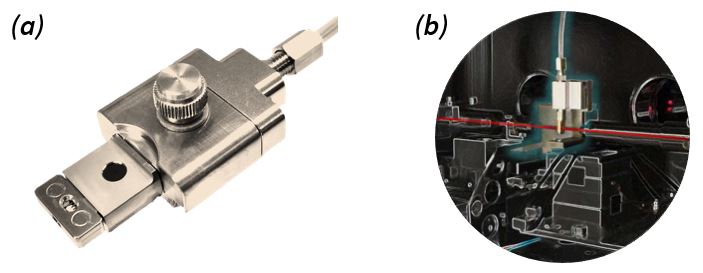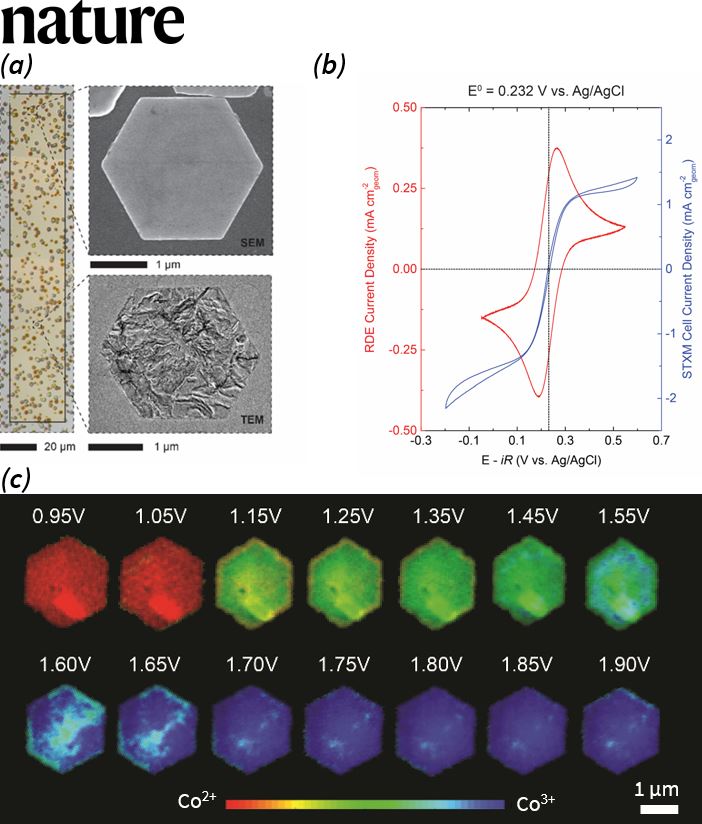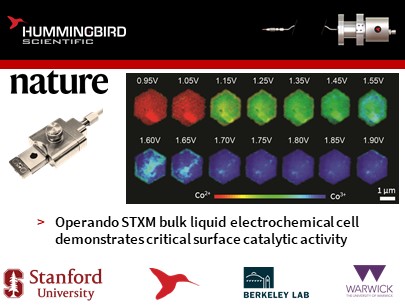Hummingbird Scientific is leading and advancing liquid cell microscopy for more than 15 years. Recently, we supported and collaborated with Prof. Will Chueh group to develop the most advanced liquid electrochemistry cell system for synchrotron scanning transmission x-ray microscopy (STXM).
The operando X-ray bulk liquid electrochemistry holder operation allows measuring the local operational chemical, physical, and electron nanoscale structure of the particle/s. quantitative electrochemical behavior from the cell directly corresponds to a large-scale electrochemical with bulk properties, mainly owing to the real reference electrode built into the system.
In the latest issue of the prestigious journal, Nature, Chueh et al. in collaboration with Hummingbird Scientific, Advanced Light Source (Lawrence Berkeley National Laboratory) and the University of Warwick used the operando STXM cell to demonstrate for the first time the surface site activity of transition metal (oxy) hydroxides with an electrochemical stimulus for developing a promising electrocatalyst for the oxygen evolution reaction (OER). This reaction is key in water splitting to generate Hydrogen that can be used to store energy.

Using Hummingbird STXM bulk liquid cell system, Prof. Chueh and his team studied the OER activity of a single-crystalline β-Co(OH)2 platelet particles by encapsulating between two silicon nitride transparent windows of the microfabricated chips through which aqueous electrolyte solution would continuously flow around the sample for electrochemical measurement.
The incorporation of real reference electrodes such as Ag/AgCl in the system allows high electrochemical fidelity of the operando STXM cell. For example, the current-potential relationship in the operando STXM cell shows similar Tafel slopes at the same potentials to the bulk-scale rotating disk electrode (RDE) tests validating the high electrochemical fidelity of the operando STXM cell.

The data from the STXM electrochemical shows heterogeneity in the distribution of Co3+ species in the β-Co(OH)2 particles with an increase in the voltage. However, the electrochemical current is primarily restricted to the particle edge facets. The local concentration of higher Co oxidation state (Co3+) compared to the bulk of the particles suggests that layered oxides’ OER activity can be improved by improvising the surface morphology.
Learn more about the Operando X-Ray Bulk Liquid Electrochemistry Holder used in the experiment
Reference: J. Tyler Mefford, Andrew R. Akbashev, Minkyung Kang, Cameron L. Bentley, William E. Gent, Daan Hein Alsem, Norman Salmon, David A. Shapiro, Patrick R. Unwin, William C. Chueh. “Correlative operando microscopy of oxygen evolution electrocatalysts,” Nature (2021). Full Paper
View All News

